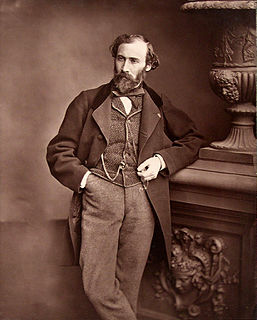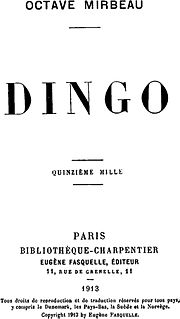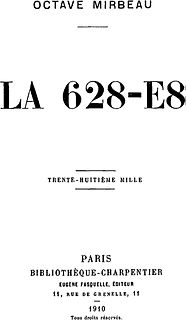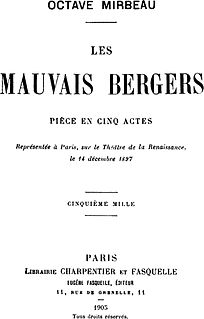Un gentilhomme is a novel by the French novelist and playwright Octave Mirbeau, published by Flammarion in 1920, after his death. Only three chapters were published.
Contents

Un gentilhomme is a novel by the French novelist and playwright Octave Mirbeau, published by Flammarion in 1920, after his death. Only three chapters were published.

It was in the mid-1890s that Octave Mirbeau first began contemplating work on a novel on a great landowner. In 1900 he had entertained the idea of a book of epic dimensions – like Leo Tolstoy's War and Peace – except set in France in the last quarter of the nineteenth century, beginning at the time of the Marshall Mac-Mahon's "coup d'état" on May 16, 1877. However, the three chapters published by his widow, the former actress Alice Regnault, are discontinued on the eve of the coup...
Apparently, the undertaking that Mirbeau envisaged soon appeared to him to be one that exceeded his capabilities, and also was one that would be at odds with his own evolving views on the novel. Whereas Mirbeau had been increasingly drawn to unconventional plot narratives, disorienting because of their equivocal meaning and lack of linear structure (see Torture Garden and Les Vingt et un Jours d'un neurasthénique ), his new project would require him to supply an abundance of explanatory background to contextualize the contemporary history his book was to treat, as if such historical reality was really accessible at all.
The principal interest of Mirbeau's three completed chapters comes because they refocused the novelist on his own literary origins. Like Mirbeau, his protagonist-narrative, Charles Varnat, enters, as a personal secretary, into the service of a Normand country squire, the Marquis d'Amblezy-Sérac, a man of vast political ambition. Mirbeau's story serves as a pretext for him to return to the years when he himself had been obliged to earn his daily bread by hiring his pen out to a succession of employers.
These experiences had left Mirbeau embittered by memories of his humiliation and frustration. Here again, as in the articles and stories dating from the 1880s, Mirbeau likens the lot of this intellectual proletariat to prostitution, and compares the life of a personal secretary to that of a servant, albeit an even more degraded one.

Octave Mirbeau was a French novelist, art critic, travel writer, pamphleteer, journalist, and playwright, who achieved celebrity in Europe and great success among the public, while still appealing to the literary and artistic avant-garde with highly transgressive novels that explored violence, abuse and psychological detachment. His work has been translated into thirty languages.

Pierre Loti was a French naval officer and novelist, known for his exotic novels and short stories.

Maurice Marie Émile Leblanc was a French novelist and writer of short stories, known primarily as the creator of the fictional gentleman thief and detective Arsène Lupin, often described as a French counterpart to Arthur Conan Doyle's creation Sherlock Holmes.

Octave Feuillet was a French novelist and dramatist.

Alvah Cecil Bessie was an American novelist, journalist and screenwriter who was imprisoned for ten months and blacklisted by the movie studio bosses for being one of the group known as the Hollywood Ten.

The Diary of a Chambermaid is a 1900 decadent novel by Octave Mirbeau, published during the Dreyfus Affair. First published in serialized form in L’Écho de Paris from 1891 to 1892, Mirbeau’s novel was reworked and polished before appearing in the Dreyfusard journal La Revue Blanche in 1900.

The Torture Garden is a novel written by the French journalist, novelist and playwright Octave Mirbeau, and was first published in 1899 during the Dreyfus affair. The novel is dedicated: "To the priests, the soldiers, the judges, to those people who educate, instruct and govern men, I dedicate these pages of Murder and Blood."

Dingo is a novel by the French novelist and playwright Octave Mirbeau (1913).

La 628-E8 is a novel by the French novelist and playwright Octave Mirbeau, published by Fasquelle in 1907. Part travelogue, part fantasy, part cultural commentary and critique, Mirbeau's book highlights its own unclassifiability: "Is it a diary?”, the narrator wonders. "Is it even the account of a trip?”
Dans le ciel is a novel written by the French journalist, novelist and playwright Octave Mirbeau. First published in serialized installments in L'Écho de Paris between September 1892 and May 1893, Dans le ciel, assembled and edited by Pierre Michel and Jean-François Nivet, first appeared its present form in 1989.

Sébastien Roch is a novel written by the French journalist, novelist and playwright Octave Mirbeau, and published by Charpentier in 1890. Last French edition : L'Age d'Homme, 2011.

L'Abbé Jules is a novel written by the French journalist, novelist and playwright Octave Mirbeau, and published by Ollendorff in 1888.

Les Vingt et un Jours d'un neurasthénique is an expressionist novel by the French writer Octave Mirbeau, published by Charpentier-Fasquelle in August 1901.

Les Mauvais Bergers is a modern tragedy, in five acts, by the French journalist, novelist and playwright Octave Mirbeau, performed in December 1897 on the stage of Théâtre de la Renaissance, in Paris, then published by Charpentier-Fasquelle in March 1898. The main parts were played by the two most famous French actors at the time: Sarah Bernhardt, as Madeleine, and Lucien Guitry, as Jean Roule.

Home, also translated as Charity, is a French three-act comedy by the novelist and playwright Octave Mirbeau, written in collaboration with Thadée Natanson. It was performed in December 1908 on the stage of the Comédie-Française, in Paris.

Célestine is the main character and the narrator of the French novel by Octave Mirbeau, The Diary of a Chambermaid, 1900.
Clara is the main character in the French Novel The Torture Garden, by Octave Mirbeau.
La Mort de Balzac by Octave Mirbeau is a collection of three sub-chapters that were initially intended to appear in Mirbeau's La 628-E8, in November 1907, but were then withdrawn at the last moment at the request of the 80-year daughter of Madame Hanska, the Countess of Mniszech. La Mort de Balzac was published by Pierre Michel and Jean-François Nivet in 1989, in the Editions du Lerot, and then in 1999, in the Editions du Félin. Published at « the expenses of an admirer », in earlier edition, limited to 250 copies, the three sub-chapters had appeared in 1918 under the title Balzac.
A story by French writer Octave Mirbeau, Les Mémoires de mon ami was first published serially in Le Journal between November 27, 1898 and April 30, 1899, in the midst of the Dreyfus Affair. After the author’s death, it was collected in a volume published in 1919 Chez l'Illustre écrivain by Flammarion and then as a booklet in the collection "Une heure d’oubli", published also by Flammarion in 1920. The most recent edition, comprising 152 pages, appeared in 2007 in L'Arbre Vengeur (Talence).
Contes cruels is a two-volume set of about 150 tales and short stories by the 19th-century French writer Octave Mirbeau, collected and edited by Pierre Michel and Jean-François Nivet and published in two volumes in 1990 by Librairie Séguier. The title was taken from Auguste Villiers de l'Isle-Adam, of whom Mirbeau was a friend and admirer.